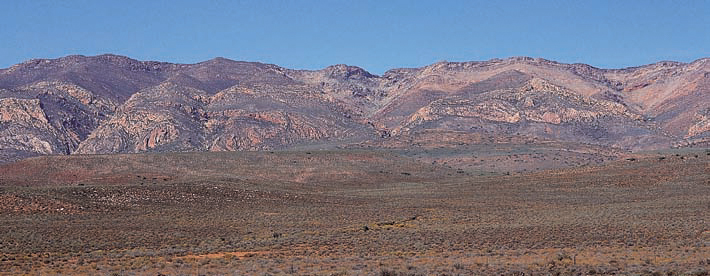

The flowers of the desert-dwelling Aloe dichotoma are a bright, butter yellow, while the exserted stamens are a contrasting purplish colour.

Apart from the well-known Namib and Kalahari deserts, large parts of southern Africa are subject to low rainfall and reasonably predictable droughts. Although this landscape, viewed towards the Witteberg mountain range from Whitehill, a small railway siding in the Karoo, appears to harbour a low diversity of plants, it is a succulent paradise, with numerous miniature species hiding under the low-growing shrubs.
The term ‘desert’ is not widely used to describe the often exceptionally dry western parts of southern Africa. For example, we virtually never hear reference to the ‘Richtersveld Desert’, just the Richtersveld. Even the Karoo, of which there are several distinct regions, is not called the Karoo Desert, despite the word being derived from the Khoekhoe word ‘garo’ meaning ‘land of thirst’. In South Africa, semi-desert conditions are often described as ‘karroid’ conditions. Locally, ‘desert’ tends to be reserved for arid and hyper-arid sandy regions, like the Kalahari and the Namib, respectively. Note, however, that because of its often tree-dominated vegetation cover, the so-called Kalahari Desert (covering most of southern and central Botswana) is best described as savanna, as is shown in the map on page 55.
In southern Africa, desert-like areas occur in both winter- and summer-rainfall regions, as well as in regions that receive sparse rainfall at any time of the year. The winter-rainfall dry areas (or deserts) are probably the best-known, thanks to the mass displays of spring wildflowers in Namaqualand (see box on Mediterranean climate, page 48). The most common contributors to this floral showcase belong to the Asteraceae, the daisy family, while among the succulents, the Mesembryanthemaceae (vygie family) contributes a significant number of species. However, over 20 per cent of southern Africa’s Aloe species occur here.

This is perhaps the best known of all the tree aloes as it often occurs in photographs depicting the Namaqualand or Namibian landscape. It is a single-trunked species with a large canopy that often looks over-sized. The canopy consists of a few to many branches, each of which supports a small rosette of dull green leaves that contrast sharply with the butter-yellow flowers produced in winter. It is not the easiest of the tree aloes to keep alive outside its natural habitat.


Flower colour varies considerably in Aloe ferox, particularly in the Eastern Cape, but the orange form is the most common.
These stately, mostly single-stemmed aloes are found in the arid karroid interior. The leaves are distinctly boat-shaped and gracefully curve upwards or outwards. Stems are typically clothed in a skirt of dry leaves. Flowers are arranged into long candles, carried in winter. Flower colour varies considerably, from red through orange, pinkish, to yellow and even white. The thick, juicy leaves contain several compounds that are used in the cosmetics and pharmaceutical industries.


A magnificent tree aloe, although not nearly as common in its natural habitat or in cultivation as Aloe dichotoma. This is one of the most threatened of the southern African aloes. It has a single stem and a few large, robust branches that support smallish rosettes of leaves at their tips. The inflorescences grow from near the bottom of a rosette, first curving downward before they reach skyward in a rather lazy-looking way. The dull yellow flowers are nearly round, at least in bud stage.



In contrast to Aloe dichotoma and A. pillansii, this is usually a robust shrub. Its main stem is normally very short and supports a large, dense canopy consisting of a multitude of small rosettes. The leaves are thick and dull green, but generally somewhat smaller than those of A. dichotoma. As is the case with A. dichotoma, A. ramosissima has bright, butter-yellow flowers.

Plants do not grow very tall and consist of small, usually solitary, sometimes clump-forming, rosettes. The deep-green, triangular leaves with white markings look much like those of species of Gasteria and are densely packed into overlapping layers. Large, pinkish red flowers are carried in laxly flowered inflorescences. This was, and perhaps still is, one of the most popular aloes grown in the temperate climates of Europe and the UK, especially in greenhouses, on suburban windowsills and in the dusty windows of pubs.